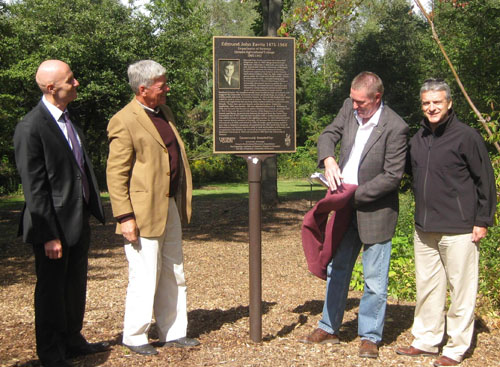
Edmund Zavitz? Sure, they named Zavitz Hall in U of G’s Branion Plaza for him, right? Wrong Zavitz, although Edmund the forester was related to Charles Zavitz, whose namesake building on campus originally housed farm programs of the Ontario Agricultural College (OAC).
To find a sign of Edmund Zavitz on campus, visit the woods at the far northeast corner of the U of G Arboretum. There, under a clutch of iconic white pines just off the Victoria Road entryway, you’ll find his name on a heritage plaque unveiled last fall after a two-year fundraising campaign led by Prof. Andy Gordon, School of Environmental Sciences (SES).
That plaque recognizes the role of an OAC professor from a century ago who eventually became chief forester and deputy forestry minister for the province. Zavitz championed reforestation projects and laws enacted by the 1940s to help protect both trees and farmland – a paradox as parts of the province had faced the threat of desertification hastened by clearing trees for farming.
Zavitz’s forestry legacy is what led Gordon to suggest erecting a commemorative plaque on campus. “He’s been inspirational to most people in the forestry industry in Ontario and probably across Canada,” says Gordon, who studies agroforestry in Canada and in developing countries.
That sentiment resonates with John Bacher, a St. Catharines author and environmentalist. Last summer Bacher published Two Billion Trees and Counting: The Legacy of Edmund Zavitz.
Released by Dundurn Press, the book recounts how its subject helped lead efforts to replant parts of Ontario to prevent flooding, erosion and fires. During the early 1900s, parts of southern Ontario – especially Norfolk County – and the Oak Ridges Moraine in south-central Ontario had become degraded. In Northern Ontario, human-induced fires had stripped soil and destroyed forests.
Born in 1875 near Ridgeway, Ont., Zavitz taught forestry at OAC and the University of Toronto between 1905 and 1912. (His cousin Charles headed OAC’s field husbandry department then.)
Among Edmund’s tree planting programs around Ontario, he led the planting of the white pines that now tower over that new heritage plaque in the arboretum. While at OAC, he wrote about farm forestry and studied the desert-prone Oak Ridges Moraine.
He also established a tree nursery that was moved to St. Williams, Ont., and run by OAC until 1912. In that year, Zavitz moved to the provincial department of lands, forests and mines, where he became chief forester of Ontario, deputy minister of forests and director of reforestation.
A month before Zavitz’s death in 1968, then-premier John Robarts planted the billionth tree in Ontario under a provincial reforestation program. More than one billion have since been planted.
Those details are included in Bacher’s book. (Also mentioned is former OAC agriculture professor William Brown, for whom a small wood west of the Ontario Veterinary College is named.)
Bacher studied history at McMaster University and co-wrote Get a Life: An Environmentalist’s Guide to Better Living. He is a researcher with the Preservation of Agricultural Lands Society based in St. Catharines.
He says farmers still need to plant trees to prevent erosion and soak up excess fertilizers, lessening runoff and helping keep streams and lakes clean. “We need to provide trees to landowners at reasonable cost to reforest their land,” says Bacher.
Bacher has also lectured on campus in an ecology course taught by integrative biology professor Kevin McCann and in a forest science course taught by SES Prof. Madhur Anand.